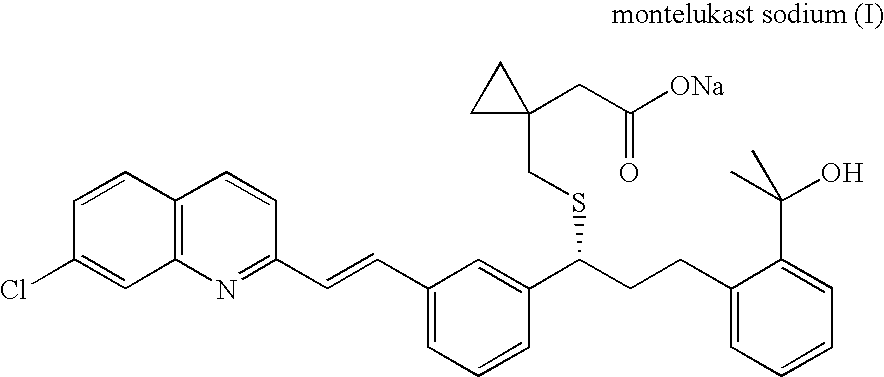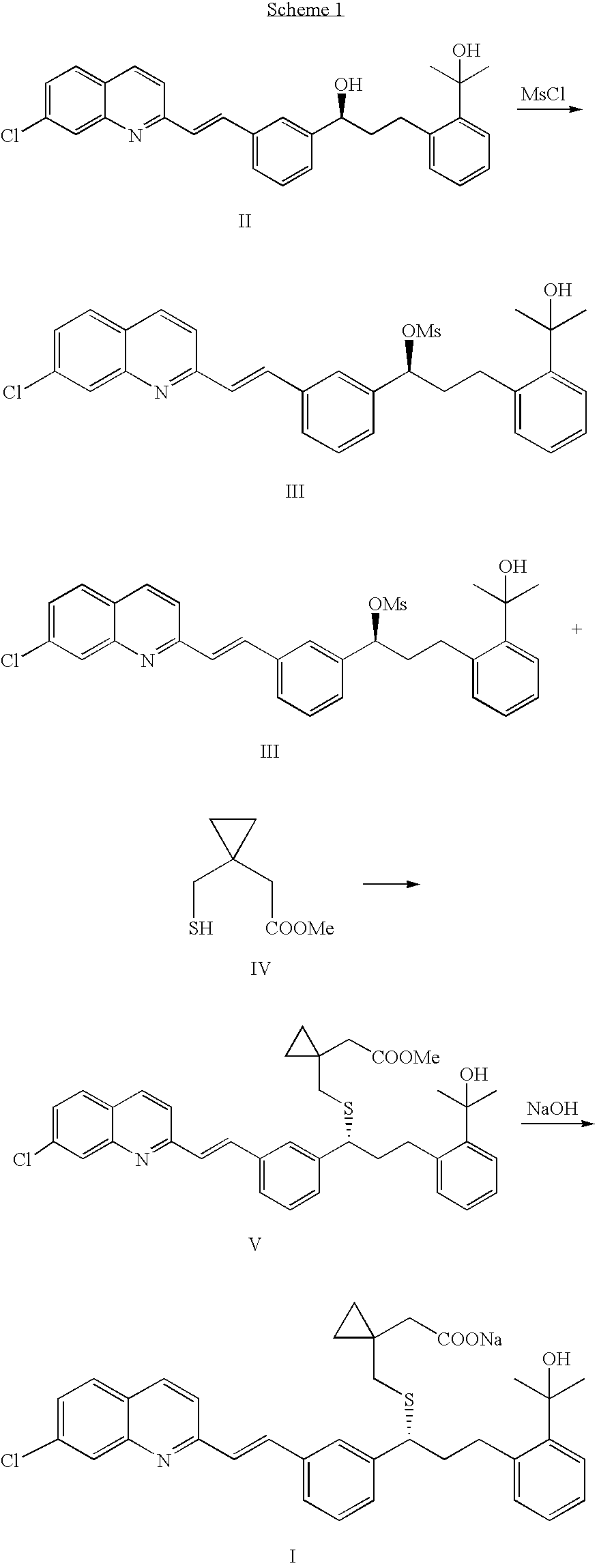Process for preparing montelukast sodium containing controlled levels of impurities
- Summary
- Abstract
- Description
- Claims
- Application Information
AI Technical Summary
Benefits of technology
Problems solved by technology
Method used
Image
Examples
example 1
Preparation of Montelukast Sodium
[0056]A three-necked flask equipped with a thermometer, a nitrogen inlet and a magnetic stirrer was charged at room temperature with 9 g (0.0198 moles) of 2-(2-(3(S)-(3-(7-chloro-2-quinolinyl)ethenyl)phenyl)-3-(hydroxylpropyl)phenyl)-2-propanol (compound (II)) in 48 mL of anhydrous THF under stirring and cooled to about −20° C. N,N-diisopropylethylamine (DIPEA) (7.8 mL; 0.045 moles) was added in portions followed by addition of 3 mL (0.039 moles) of methanesulfonyl chloride in portions, and stirring was maintained at about −20° C. for about 2 hours. An aliquot was checked by HPLC, which contained less than 1% of the starting material, and about 1.5% of compound (VI) in the reaction mixture. The cold suspension containing the product 2-(2-(3S)-(3-(7-chloro-2-quinolinyl)ethenyl)phenyl)-3-(methanesulfonyloxypropyl)phenyl-2-propanol (compound (III)) was filtered at −20° C. and washed with cold anhydrous THF.
[0057]Another three-necked flask equipped with ...
example 2
Preparation of Montelukast Sodium
[0059]A three-necked flask equipped with a thermometer, a nitrogen inlet and a magnetic stirrer was charged at room temperature with 9 g (0.0198 moles) of compound (II) in 48 mL of anhydrous THF under stirring and cooled to about −20° C. N,N-diisopropylethylamine (DIPEA; 4.8 mL; 0.028 moles) was added in portions followed by addition of 1.86 mL (0.024 moles) of methanesulfonyl chloride in portions, and stirring was maintained at about −20° C. for about 2 hours. A sample was withdrawn and checked by HPLC, which contained about 5% of the starting material, and about 0.5% of compound (VI) in the reaction mixture. The cold suspension containing the product compound (III), was filtered at −20° C. and the cake was washed with cold anhydrous THF.
[0060]Another three-necked flask equipped with a thermometer, a nitrogen inlet and a magnetic stirrer was charged at room temperature with 7.3 g (0.05 moles) of compound (VII) and 48 mL of NMP under stirring and und...
example 3
Preparation of Montelukast Sodium Salt
[0061]A dry reactor was charged at room temperature with 1.21 kg (2.66 mol) compound (II) and 6 L of anhydrous THF, cooled to 0° C. while stirring. DIEA (650 mL, 3.25 mol; 1.22 equiv.) was added in portions. A solution of methanesulfonyl chloride (250 mL, 3.25 mol, 1.22 equiv.) in 500 mL THF then was added to the stirred reaction mixture over a hour, while the temperature of the reaction mixture was maintained at or around 0° C. for about 3 hours. A sample of the reaction mixture was checked by HPLC, and indicated there was 0.74% of the starting material (compound (II)), and 0.3% of compound (VI). The cold reaction mixture then was filtered at 0° C. and the cake washed with 1 L anhydrous THF, then 2 L THF. The solution, containing the product (compound (III)) was then transferred to a clean and dry container.
[0062]Compound (VII) (480 g, 3.29 mol) was added to a clean and dry reactor at room temperature, followed by NMP (6.48 L) to form a solutio...
PUM
 Login to View More
Login to View More Abstract
Description
Claims
Application Information
 Login to View More
Login to View More - R&D
- Intellectual Property
- Life Sciences
- Materials
- Tech Scout
- Unparalleled Data Quality
- Higher Quality Content
- 60% Fewer Hallucinations
Browse by: Latest US Patents, China's latest patents, Technical Efficacy Thesaurus, Application Domain, Technology Topic, Popular Technical Reports.
© 2025 PatSnap. All rights reserved.Legal|Privacy policy|Modern Slavery Act Transparency Statement|Sitemap|About US| Contact US: help@patsnap.com



